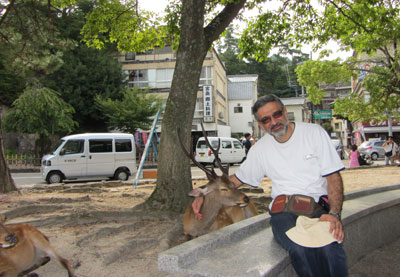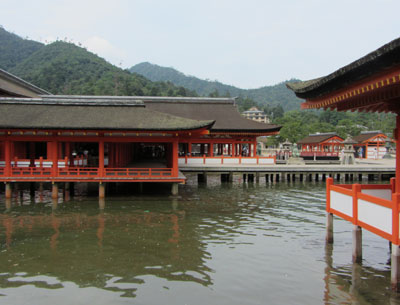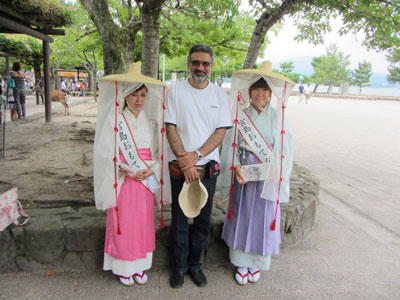Hiroshima Travelogue- Episode 9
August 5, 2013
We are taken to another beach the next morning to visit another isle. There are vessels to carry only human passengers from the beach to the isle. The vessels which were used for going to the Econojima isle could carry cars as well. The vessel breaks through the beautiful water to the isle. The green heights of the isle can be seen from the vessel. A little further, a religious sign can be seen in the water near the isle.

We arrive in Miyajima Island. The tangible serenity of the area embraces us all upon our arrival. Here are no stuff brokers with their annoying bullhorns nor are one-stroke engines whose exhausts are tampered with. Astonished enough with the scenery, we see a little further a herd of absolutely tamed deer standing or sitting around.


I move forward to one of the deer and take a picture with it. There are more religious signs on the way; dragon-like taps, the gateway of gods, and a great temple with its wooden pillars all stationed in the water. The isle is said to be among world heritage and its religious background dates back to over 1,200 years ago when a Buddhist priest came to Miyajima in search of light and stayed in one of the mounts in the region. Just like other religious structures that I have so far seen in Japan, here is a tourist attraction as well. The island’s economy depends on the shops placed in a market about the temples rather than the temples themselves.
As we pass through the shops, we hand over some of our exchanged dollars to the shopkeepers. Upon my return, I can’t help stopping by and taking a picture with two female guides who wear local garments.

Free in the afternoon, we get out of our one-bed rooms and walk about to see Hiroshima. It’s a newly-built city. After the atomic disaster, only one building has been kept intact as a symbol of the incident and the rest of the city is renewed, as it should.
I see neither garbage nor garbage bins in the streets. “Such a great idea for not producing garbage,†I think. You cannot smoke in the city except before special stores or some parks where ashtrays are installed.
A considerable number of individuals ride bicycles in specially designed ways in pedestrians. Some also move about in streetcars. Some of the streetcars are dated and belong to the time when the bombs fell on the city. They have kept them to restore to life the memory of the incident.
There are so many cars, but none stop I the streets except very shortly or out of necessity. The traffic lights are respected like they are divine. The pedestrians are revered the same.
Every driver seems to believe wholeheartedly in the priority of walkers. All pedestrians and traffic lights for the visually handicapped are specially designed to suit them. The way of cars is well-defined. No one is allowed to change lines. Every line has a specific light. A line can happen to be filled with cars while its adjacent line is free for the cars to rush along.
One envies the citizen’s tranquility.
Hedayatollah Behboudi
Translated by Abbas Hajihashemi
Number of Visits: 5424








The latest
- Third Regiment: Memoirs of an Iraqi Prisoner of War Doctor – 11
- 100 Questions/10
- The 23rd Commemoration Ceremony of the Martyrs of the Ansar al-Rasul Battalion Held
- A Narrative of Pakistani Pedestrian Pilgrims of Arbaeen in Sistan and Baluchestan
- Oral History Methodology/National Archives and Library Organization of Iran, Archives Research Institute
- Third Regiment: Memoirs of an Iraqi Prisoner of War Doctor – 10
- 100 Questions/9
- Oral History News – Aban 1404
Most visited
- Third Regiment: Memoirs of an Iraqi Prisoner of War Doctor – 9
- The Relationship between “Religious Jurisprudence” and “Oral History”
- Oral History News – Aban 1404
- Oral History Methodology/National Archives and Library Organization of Iran, Archives Research Institute
- 100 Questions/9
- Third Regiment: Memoirs of an Iraqi Prisoner of War Doctor – 10
- A Narrative of Pakistani Pedestrian Pilgrims of Arbaeen in Sistan and Baluchestan
- The 23rd Commemoration Ceremony of the Martyrs of the Ansar al-Rasul Battalion Held
100 Questions/6
We asked several researchers and activists in the field of oral history to express their views on oral history questions. The names of each participant are listed at the beginning of their answers, and the text of all answers will be published on this portal by the end of the week. The goal of this project is to open new doors to an issue and promote scientific discussions in the field of oral history.The Importance of Pre-Publication Critique of Oral History Works
According to the Oral History website, a meeting for critique and review of the book “Oral History: Essence and Method” was held on Monday morning, November 10, 2025, with the attendance of the book’s author, Hamid Qazvini, and the critics Mohammad Qasemipour and Yahya Niazi, at the Ghasr-e Shirin Hall of the National Museum of the Islamic Revolution and Sacred Defense.Challenges of Interviewing in Oral History
After years of studying the theoretical foundations of oral history, conducting numerous interviews and going through their post-interview stages, as well as reading the available body of oral history literature, I was eventually given the opportunity to evaluate the edited versions of dozens of oral history projects.Comparing the Narratives of Commanders and Ordinary Combatants in the Sacred Defense
An Analysis of Functions and ConsequencesThe experience of the Sacred Defense cannot be comprehended merely through statistics or official reports; what truly endures from war are the narratives of those who stood upon its frontlines. These narratives, however, vary significantly depending on one’s position, responsibilities, and lived experience.


